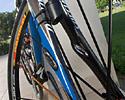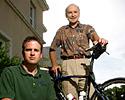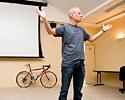
Recently on Cyclingnews.com |
Tech feature: Specialized refines Roubaix comfort superbike, June 21, 2006Roubaix @ Roubaix - Specializing in cobblesSpecialized's entry into European pro road racing as sponsor of the Gerolsteiner team has given the company a powerful incentive to develop its road bikes for the needs of some of the world's top riders. The shock-damping Roubaix bike is one of the most interesting machines to emerge from the Specialized development bunker. Ben Atkins was at the launch of the 2007 version of the bike's super-light pro racing incarnation, the S-Works Roubaix SL - and so was one of his heroes, one Johan Museeuw.
On the second weekend of June this year, Specialized Bicycles assembled a motley international group of cycle journalists and aspiring classics heroes in northern France to witness the launch of Specialized's latest assault on the Cobbled Classics, the new S-Works Roubaix SL. The venue was the Dolce Hotel, not far from the beautiful Chateau de Chantilly, in an area famous for its lace, and bizarrely synonymous in France with whipped cream! It is used every April by some of the teams racing in the Paris - Roubaix. Chantilly has an important place in the history of the Paris-Roubaix. In 1968 when the first modern race took place, the organisers had to move the start north of Paris to allow for the twists and turns of the new course. The place chosen was Chantilly, the race was won by Eddy Merckx, and neither he nor it looked back. The race has since got even more twisty and so the start has moved a few kilometres to the east to the Imperial town of Compiegne. As well as the guys from Specialized, we have some help from Yellow Jersey Tours to look after our every whim. Nikane will be organising the rides and driving the team car and she'll be ably backed up by Patxi and Pedri, two Basque soigneurs - who have had lots of top Euskal pros legs under their care. As guides on our ride we also have a Continental pro, Belgian Tim Meeusen and a Flandrian legend Jo Planckaert (second at Roubaix in 1997). If this wasn't enough, we have a special guest with us, to make the Roubaix experience all the more authentic - it's Johan Museeuw! My absolute hero! The bikeThe main reason we'd been assembled here in this part of France was to witness the unveiling of the 2007 S-Works Roubaix SL. The unveiling took the form of a multimedia presentation with Specialized founder and CEO, Mike Sinyard. Tech gurus Chris D'Aluisio and Luc Callaghan went through the philosophy behind the Roubaix. They also listed a great many of the technical stats that set this new frame apart from the other bikes in the Specialized stable - what they feel sets it apart from the other brands in the peloton. The most noticeable thing about the new S-Works frame is its curvy tubes. At first glance it looks more like a Tarmac than a Roubaix. Closer inspection though reveals the other change - a new look to the seatstays and forks - the things that identify this frame as definitely a Roubaix - the Zertz. The Zertz (elastomer inserts) on the 2007 SL are in a similar place to the existing Roubaix frames, i.e. one in each seatstay, and one in each fork blade - as well as the one in the seat post. these new inserts, however - particularly those at the rear - have been re-scuplted to allow for even more vertical damping, giving the front and rear of the bike an appearance reminiscent of the curves on a Pinarello Dogma. Regardless of shape though, according to statistics gathered using Specialized's own test benches, the S-Works Roubaix SL is one of the most vertically compliant (i.e. comfy) frames out there, while still remaining up there with the best in terms of bottom bracket stiffness and torsional rigidity. All this adds up, claims Specialized, to a bike that will transfer as much as possible of your power to the road, while at the same time stopping the road form transferring its power to you. Although the S-works SL looks entirely different from the other frames in the Roubaix stable, it does have the same geometry. The Tarmac-style tubes and wiggly Zertz areas have been changed in order to enhance the frames characteristics and to make it look more "sexy" - the last point being most important for many of us. The elite application of the Roubaix is obviously the cobbled classics, but surprisingly this is not the origin of the design. With the Roubaix frames, Specialized is attempting to do on the road what it did with the Stumpjumper off it - to create a bike that everyone will feel comfortable riding. The longer wheelbase (retaining the standard fork rake) and Zertz not only help the bike to take some of the sting out of some of France's most notorious cart tracks, but is also meant to make the longest rides more comfortable, allowing everyone to ride all day without getting beaten up by the road surface. The fitSpecialized had already asked us for our usual bike measurements in order to assemble a bike that is as close as possible to the one we ride at home. Before we're allowed anywhere near it though, we had to make it fit. For this task we were put under the care of Andy Pruitt and Todd Carver from the Boulder Center for Sports Medicine (BCSM). Pruitt has been in sports medicine for over 30 years, working with such elite athletes as Gunn-Rita Dahle and Floyd Landis. He literally wrote the book on cycling and medicine - "Complete Medical Guide for Cyclists" - and while he's not actually the father of Specialized Body Geometry he's certainly a fraternal uncle. A presentation from Pruitt focused on two key areas; the correct treatment of the contact points with the bike (hands, feet, 'saddle area') and the neutral position on the bike. Pruitt's ideas on contact fit nicely with the features of a lot of Specialized's Body Geometry products. This is no coincidence as he works very closely with Specialized in development. Andy Pruitt seems to be most proud of the Body geometry range of shoes. His studies - and studies performed by others - show that 85 percent of people's feet are naturally lower on the outside (little toe), meaning that when the pedal is pressed the knee moves to one side, putting pressure on the joints and sometimes causing injury. You can see this for yourself by watching your knees get closer to the top tube in the middle of the stroke. Pruitt's work with Specialized has produced the range of Body Geometry shoes - the latest of which we were presented with this weekend - designed to correct this problem by supporting the foot at its natural angle, thus making the knew bend in a straight line, minimising the chance of injury. After the presentation I had a one on one session with Todd Carver to fine tune my position. With the bike set up to the measurements I'd sent in, Carver fitted my cleats to the new BG shoes (by sight alone, and was spot on!) and watched me as I pedaled. In the end I was pretty much perfect - if I do say so - and we switched the 120mm stem for a 110 with a minus 8 degree angle, basically because the top tube is 5mm longer than my bike at home. Otherwise, all my angles and measurements were within the right ranges, a Gold star for the old Italian that fitted my custom Battaglin! The rideUnfortunately we weren't to ride all 250+km of the Paris-Roubaix course, but our plan for the day was to drive to St Quentin - part way along the course - then ride north for around 80-90km, taking in around seven or eight sectors of pavé. You can picture the scene - Jo Planckaert, a dozen or so wannabe Museeuws, and... Museeuw. The first 20 - 30 km, before we reached Troisvilles and the first pavé sector, the time was used well. Everybody took turns to be photographed with the Lieeuw of Flanders. I'm not sure how he felt about this, but I guess that was what he was there for! Finally the pavé arrived. The sector at Troisvilles is only rated as a three-star sector, which is quite enough to get started with. It's predominantly downhill for the first half before turning sharp left and levelling out, it's a lovely way to spend a sunny afternoon! It was a great pleasure riding over my favourite roads on a quality bike that was designed for the purpose. The fact that it was someone else's bike just added to the experience. It wouldn't be my problem if it broke, but there was no way this bike was going to break! Compared to my previous excursions onto these beautiful 'roads' on a full aluminium frame, the bike felt pretty plush. The sting was definitely taken out of the bumps . Whether the geometry or the Zertz was responsible for that isn't obvious, but whatever the specific reason Specialized has certainly got something right here. As a total self confessed pavé-aholic, I attacked each sector like Fabien Cancellara. Sadly, unlike Fabian Cancellara, I tended to run out of steam when the road started to rise in front of me. Even the slightest upward gradient on this kind of surface can turn into a real leg sapper once your speed drops, and I tended to get overtaken by a steady stream of other journos and Specialized staff on every sector. But I didn't care, if I went slowly it just meant that I got more time on the pavé! After a few hours of this exquisite torture, under atypically sunny skies for this sort of course, we rolled up to the waiting vans in the village of Aulnoy-les-Valenciennes. It was all over too soon, we'd done around a third of the cobbled sectors and I wanted more. Actually, what I wanted was Pablo to work his magic on my legs again, he's a miracle worker! Look out for a full test of the Specialized S-Works Roubaix SL in the near future. PhotographyFor a thumbnail gallery of these images, click here Images by Karel Duerinckx/Specialized
|














